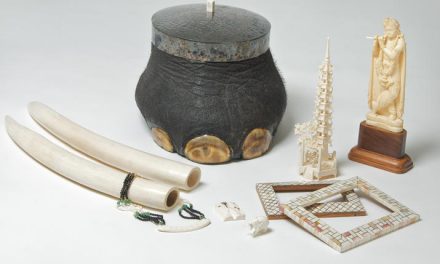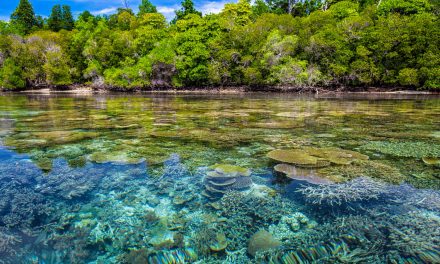When I’m not assisting Natural Habitat Adventures in making our company the most sustainable, epic travel company on the planet, I am also a student pursuing my master’s degree in conservation biology. Part of my program at Miami University requires that I spend a portion of each summer conducting in-field research, and this year my research took place in Malaysian Borneo. I was excited to visit Borneo, because Natural Habitat Adventures’ travelers visit the same areas that I would be living in. I knew I would get to witness the inspirational work of Wong Siew Te at the Bornean Sun Bear Conservation Center and have an opportunity to possibly spot wild pygmy elephants, the smallest elephant on the planet. Yet, the amount I learned far exceeded my expectations, and I returned to Nat Hab with newfound insight on conservation and our mission.

This is the Natural Habitat Adventures’ logo at the Bornean Sun Bear Conservation Center! Finding our company’s impact halfway around the world was a pretty amazing moment.
Community Involvement is Key to Conservation
Community-based conservation is a term you hear a lot in conservation biology. Essentially, it is the concept of local communities using their knowledge and cultures to develop conservation strategies that are sustainable long-term. The village of Sukau in Malaysian Borneo is perhaps one of the best examples of community-based conservation in the world. Members of this small community train to become “wildlife wardens,” where they volunteer to protect the rain forest from poachers. Hutan, an non-governmental organization (NGO) dedicated to studying orangutans in Sabah, oversees a variety of community conservation initiatives in Sukau. For example, there is a female-run reforestation project, where women plant trees daily in an effort to study and replenish the destroyed forest. Without this effort from local communities, this ecosystem would likely be destroyed. In addition, by involving the local community in conservation, there is a better chance at long-term preservation of the rain forest.

Hutan’s female led reforestation team with our graduate school group replanting the rain forest.
The Illegal Wildlife Trade is a Serious Problem
It’s sometimes easy to separate ourselves from issues that happen in other parts of the world because we aren’t faced with them on a daily basis. It didn’t occur to me how much our social media posts and conversations impact our perception of wild animals. Each year, for example, baby orangutans are forcibly taken from their mothers and sold as pets. Once orangutans become too large and aggressive to keep as pets, though, they often end up in wildlife rehabilitation centers, where they are so mentally traumatized that they cannot be released back into the wild.
When we talk about cute animals, we often say things like, “I want one” or “I want to hold it.” When we see these animals, we often post photos and videos taken in close proximity. To help put a stop to the illegal wildlife trade, we must encourage each other to be mindful of the way we interact, photograph and talk about wildlife.

Here, I’m using a GPS tracker to locate wild python in the rain forest as part of a Ph.D. study.
What You Post and Share Matters
Throughout my research, I worked on a variety of Ph.D. projects, including a study on the behaviors of wild pangolin. Pangolins are the world’s most trafficked animal, with approximately 100,000 taken out of the wild each year, according to WildAid. These vulnerable mammals are hunted for their meat and scales, which are used in a variety of traditional medicines. I had the opportunity to track pangolins during my time in Borneo, where our group was lucky enough to see a critically endangered Sunda pangolin. Giddy with excitement, we all took our phones and cameras out, hoping to get a photo of the rare species.
The lead Ph.D. student quickly explained that anything we post online will include a geographic tracker that poachers could use to find that specific animal and kill the pangolin. It had never occurred to me before how my social media posts could directly impact wildlife. I began to rethink the type of photos that I both see and post. Selfies with animals are typically popular photos, but what do these photos say to the public? Our posts can fuel the illegal pet trade by making wild animals seem cute and cuddly. Captive slow lorises, for example, often will be mistaken for acting cute when tickled, when in reality, the animal is trying to defend itself and is stressed. As an employee at a company that only offers wildlife experiences through highly vetted, responsible institutions, I feel that it is important that we spread the message to think before you post.

This photo was taken along the Kinabatangan River when I first spotted wild pygmy elephants. The image was taken from my boat, which was a safe, respectful distance from the elephants.
Conservation Issues are Not Black and White
“For every complex problem there is an answer that is clear, simple and wrong.”
– Quote by Henry Louis Mencken, the ‘Sage of Baltimore’
When you’re on the ground dealing with conservation issues, you begin to hear more and more voices of varying opinions. While we would like to believe each conservation issue has a clear answer, unfortunately, the actual dynamics are often more complicated than that. Palm oil, for example, is often regarded as a large threat to orangutans and other rain forest species. The natural response to the palm oil problem is to boycott the product altogether, but this has other ramifications. One is that palm oil is a major cash crop for Malaysia and Indonesia, where over 80% of the world’s palm oil comes from, according to National Geographic. Palm oil is also one of the most efficient oils, utilizing significantly less land for a higher yield. If consumers simply switched to an alternative oil, that would have harmful impacts on economies and have more environmental consequences. This complex problem is, unfortunately, not as simple as boycotting or banning palm oil. Rather, we must work together with various stakeholders to determine the most efficient way to stabilize livelihoods and preserve ecosystems.

My graduate school program opened my eyes to community-based conservation and what obstacles exist in wildlife conservation. Borneo is truly a magical place that feels wild in the best way. Living along the Kinabatangan River opened my eyes to a small pocket of wild rain forest still preserved in our industrialized world.
I urge you to spread awareness and educate others on their words, photos and social media posts when visiting animals in their natural habitats. In order to keep the wild wild, we need to listen to all stakeholders to find solutions that can sustain both our growing populations and our special places.


































